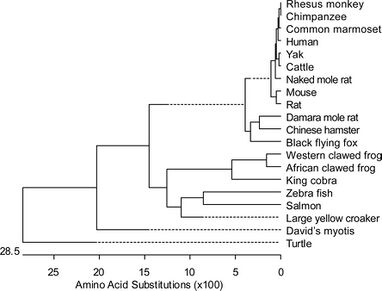Biology:Calponin 3, acidic
 Generic protein structure example |
Calponin 3. acidic is a protein that in humans is encoded by the CNN3 gene.
The CNN3 gene is located at 1p22-p21[1] in the human chromosomal genome. CNN3 gene contains 7 exons and encodes calponin 3, a 36.4-kDa protein consisting of 329 amino acids with isoelectric point (pI) of 5.84. Calponin 3 is known as acidic calponin. Among three isoforms of calponin, less is known for the gene regulation and function of calponin 3. Nonetheless, much has been learned from extensive studies on the homologous genes CNN1 and CNN2 that encode calponin 1 and calponin 2.[2]
Evolution
CNN3 is one of the three homologous calponin isoform genes. Calponin 3 is significantly diverged from calponin 1 and calponin 2 in the C terminal variable region. The higher degree of divergence among vertebrate CNN3 genes than that in the CNN1 and CNN2 gene families suggests possibly earlier emergence of CNN3, indicating that calponin 3 may represent a prototype of calponin ancestral of the three present-day isoforms (Fig. 1).
Structure-function relationships
The primary structure of calponin 3 is similar as that of calponin 1 and calponin 2, consisting of a conserved N-terminal calponin homology (CH) domain, a conserved middle region containing two actin-binding sites, and a C-terminal variable region. The unique length amino acid sequence of the C-terminal segment of the three calponin isoforms are responsible for their size and overall charge differences.
Calponin 3 has been shown to participate in actin cytoskeleton-based activities such as that in embryonic development[3] and myogenesis.[4] Unlike calponin 1, calponin 3 has little effect on actomyosin Mg2+-ATPase activity and does not cause actin filaments bundling at the same condition as calponin 1 does.[5]
Tissue distribution
Calponin 3 is found in the brain with expression in neurons,[6][7] astrocytes,[8] and glial cells,[9] where it may function in regulating the actin cytoskeleton with a proposed role in the plasticity of neural tissues.[10][11] Calponin 3 is also present in embryonic trophoblasts and myoblasts with functions in cell fusion during embryonic development and myogenesis[3][4] Calponin 3 is also expressed in B lymphocytes.[12]
Function
Calponin 3 was found in stress fibers of skin fibroblasts and myofibroblasts during wound healing. Cnn3 knockdown in primary fibroblasts impaired stress fiber formation, resulting in decreased cell motility and contractile ability.[4]> Calponin 3 in the brain has a potential function in regulating actin filaments during neuronal remodeling.[13] Calponin 3 was also found in dendritic spines of adult hippocampal neurons to regulate dendritic spine plasticity.[11] While mice with systemic knockout of Cnn1[14] or Cnn2,[15] or both Cnn1 and Cnn2 survive to adulthood and fertile, systemic knockout of calponin 3 in mice results in embryonic and neonatal lethality due to defect in the development of central nervous system.[12] CNN3 was found in the trophoblasts of human placenta and plays a role of negative regulator of trophoblast fusion. Knockdown or dissociation of calponin 3 from cytoskeleton in response to PKC phosphorylation promoted fusion of trophoblasts.[3]
Consistently, calponin 3 was also present in myoblasts as an inhibitory regulator of cell fusion. Overexpression of calponin 3 in mouse C2C12 myoblasts inhibited cell fusion during in vitro differentiation, whereas Cnn3 gene knockdown promoted cell fusion and the expression of skeletal muscle myosin. The inhibitory effect of calponin 3 was reversed upon phosphorylation by Rho-associated kinase 1/2 (ROCK1/2).[3]
Notes
References
- ↑ "Molecular cloning and gene mapping of human basic and acidic calponins". Biochemical and Biophysical Research Communications 217 (1): 238–44. 1995. doi:10.1006/bbrc.1995.2769. PMID 8526917.
- ↑ "Calponin Isoforms CNN1, CNN2 and CNN3: Regulators for Actin Cytoskeleton Functions in Smooth Muscle and Non-Muscle Cells.". Gene 585 (1): 143–153. 2016. doi:10.1016/j.gene.2016.02.040. PMID 26970176.
- ↑ 3.0 3.1 3.2 3.3 "Calponin 3 regulates actin cytoskeleton rearrangement in trophoblastic cell fusion". Molecular Biology of the Cell 21 (22): 3973–84. 2010. doi:10.1091/mbc.E10-03-0261. PMID 20861310.
- ↑ 4.0 4.1 4.2 "Calponin 3 regulates stress fiber formation in dermal fibroblasts during wound healing". Archives of Dermatological Research 305 (7): 571–84. 2013. doi:10.1007/s00403-013-1343-8. PMID 23545751.
- ↑ "Functional analysis of rat acidic calponin". Biological & Pharmaceutical Bulletin 25 (5): 573–9. 2002. doi:10.1248/bpb.25.573. PMID 12033495.
- ↑ "Distribution of caldesmon and of the acidic isoform of calponin in cultured cerebellar neurons and in different regions of the rat brain: an immunofluorescence and confocal microscopy study". Experimental Cell Research 221 (2): 333–43. 1995. doi:10.1006/excr.1995.1383. PMID 7493632.
- ↑ "Expression of an acidic isoform of calponin in rat brain: western blots on one- or two-dimensional gels and immunolocalization in cultured cells". The Biochemical Journal 306 (1): 211–5. 1995. doi:10.1042/bj3060211. PMID 7864813.
- ↑ "Subcellular distribution of calponin and caldesmon in rat hippocampus". Brain Research 887 (2): 444–9. 2000. doi:10.1016/s0006-8993(00)03030-4. PMID 11134639.
- ↑ "Acidic calponin cloned from neural cells is differentially expressed during rat brain development". The European Journal of Neuroscience 8 (7): 1501–9. 1996. doi:10.1111/j.1460-9568.1996.tb01612.x. PMID 8758957.
- ↑ "Acidic calponin immunoreactivity in postnatal rat brain and cultures: subcellular localization in growth cones, under the plasma membrane and along actin and glial filaments". The European Journal of Neuroscience 11 (8): 2801–12. 1999. doi:10.1046/j.1460-9568.1999.00702.x. PMID 10457177.
- ↑ 11.0 11.1 "Increased levels of acidic calponin during dendritic spine plasticity after pilocarpine-induced seizures". Hippocampus 13 (7): 845–58. 2003. doi:10.1002/hipo.10136. PMID 14620880.
- ↑ 12.0 12.1 "A Conditional Knockout Mouse Model Reveals That Calponin-3 Is Dispensable for Early B Cell Development". PLOS ONE 10 (6): e0128385. 2015. doi:10.1371/journal.pone.0128385. PMID 26046660. Bibcode: 2015PLoSO..1028385F.
- ↑ "Change in the shape and density of dendritic spines caused by overexpression of acidic calponin in cultured hippocampal neurons". Hippocampus 16 (2): 183–97. 2006. doi:10.1002/hipo.20145. PMID 16358313.
- ↑ "Regulation of shortening velocity by calponin in intact contracting smooth muscles". Biochemical and Biophysical Research Communications 279 (1): 150–7. 2000. doi:10.1006/bbrc.2000.3909. PMID 11112431.
- ↑ "Role of H2-calponin in regulating macrophage motility and phagocytosis". The Journal of Biological Chemistry 283 (38): 25887–99. 2008. doi:10.1074/jbc.M801163200. PMID 18617524.
 |


